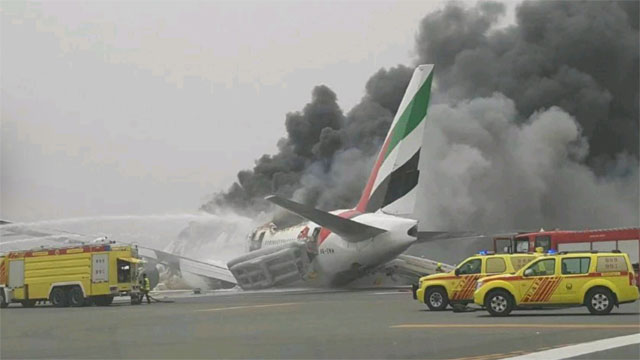A Boeing 777-300 destroyed in a fiery crash landed long and its engines were still in idle power as its pilots attempted to perform a go-around last month in Dubai, a preliminary report has revealed.
The report by Dubai’s General Civil Aviation Authority on the August 3 service from Trivandrum International Airport in India to Dubai found that the captain took over flying the plane from the co-pilot when an eight-knot headwind turned to a gradually increasing tailwind.
As the aircraft’s rear landing gear touched down about 3600ft (1100m) from the threshold of runway 12L, the pilots received an aural runway advisory system warning of “long landing, long landing’’.
The nose wheel remained in the air and four seconds later the aircraft became airborne in an attempt to do a go-around (rejected landing). The flaps were raised from the original position of flaps 30 to flaps 20 and two seconds later the landing gear lever was moved to the up position.
As the landing gear unlocked and began to retract, the crew responded correctly to an air traffic control clearance to fly straight and climb to 4,000ft.
But as the aircraft reached an altitude of 85ft, with an indicated airspeed of 134 knots, it began to sink back towards the runway.
Both crewmembers saw the airspeed decreasing and the co-pilot called out “check speed.”
“Three seconds before impact with the runway, both thrust levers were moved [manually] from the idle position to full forward,’’ the report said. “The autothrottle transitioned from idle to thrust mode.
“Approximately, one second later, a ground proximity warning system aural warning of “Don’t sink, don’t sink’’ was announced.’’
By the time the engines responded to the thrust changes , one second before impact, it was too late.
The rear of the aircraft hit the runway at 125 knots with a rate of descent of 900 ft per minute and nose up pitch angle of 9.5 degrees. The engines hit next with the three landing gears still moving towards the retracted position, one of the engines was ripped from the wing and aircraft burst into flames.
The plane came to rest adjacent to a taxiway and the passengers and crew evacuated via slides with 23 sustaining minor injuries and a cabin crew member seriously injured. A fire-fighter was also killed fighting the blaze.
The does report does not say if or when the crew hit the take-off, go-around (TO/GA power) switches, which activate an automatic go-around, but points to a Boeing 777 flight crew operations manual on the subject
The Boeing document says the mode remains active “even if the airplane touches down while executing a go-around’’. However, it also notes that TO/GA switches are inhibited on the ground and an automatic go-around cannot be initiated after touchdown.
“If a go-around is initiated after touchdown but before thrust reverser selection, continue with normal go-around procedures,’’ it says. “As thrust levers are advanced, auto speedbrakes retract and autobrakes disarm. The flight director go-around mode will not be available until go-around is selected after becoming airborne.”
Under the Boeing 777 go-around procedure, a pilot flying pushes the TO/GA switch and call “flaps 20’’ before verifying the rotation to go -around altitude and that the thrust is increasing.
The pilot monitoring verifies that the thrust is sufficient for the go-around and adjusts as needed before verifying a positive rate of climb on the altimeter and calling “positive climb’’.
The captain then verifies a positive rate of climb and calls “gear up’’ and the pilot monitoring sets the landing gear lever to up.
























